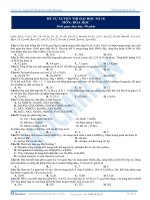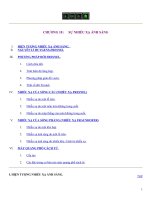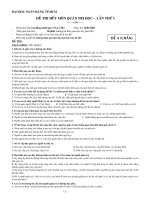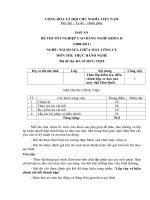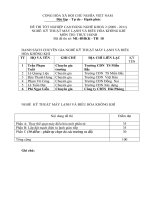PASSAGE 18
Bạn đang xem bản rút gọn của tài liệu. Xem và tải ngay bản đầy đủ của tài liệu tại đây (46.91 KB, 3 trang )
PASSAGE 18
Although people drive in all countries, the rules can be quite different between nations and areas. For
this reason, you should always learn the laws before you decide to drive in a foreign country. If you are
not careful, you can get into trouble since the rules might be very different from what you are used to. For
example, you can find some big differences in laws related to the minimum driving age, the appropriate
side of the road to drive on, and mobile phone use while driving.
In the U.S., people who live in Alaska may obtain a learner’s permit (legal permission to drive while
being supervised) at the age of fourteen. This is quite different from the driving laws of Niger, where a
person must be at least twenty-three years old to drive. If you are inquisitive to know the minimum
driving age in most countries, the answer is eighteen. It may also surprise you to learn that not every
country allows its citizens to drive, although most of them do. For example, women are not allowed to
drive in Saudi Arabia no matter how old they are. Instead, they must have a male family member or hired
male driver to travel by car.
Driving on the right or left side of the road also varies. For instance, in Great Britain, Cyprus,
Australia, India, and Malaysia people drive on the left. However, in the U.S., Mexico, France, and Canada
people are required to drive on the right. As a matter of fact, one country can have different driving rules
for different areas. People in Hong Kong drive on the left, while drivers in other parts of China use the
right side of the road.
Other driving laws that are different between countries include those related to using mobile phones.
In Japan, using any kind of mobile phone device is illegal, even if you do not need to hold the phone with
your hands. However, in Argentina and Australia, drivers are allowed to talk on their mobile phones as
long as they do not use their hands.
You might also find it interesting to learn that some countries have very unusual laws. For example, in
the country of Cyprus, it is against the law to eat or drink anything while driving. Even more interesting is
that in Germany, there is a famous road called the Autobahn, where certain parts have no speed limit at
all!
Question 1. Which of the following is TRUE according to the passage?
A. Females can drive a car in Saudi Arabia.
B. People in India drive on the right side of the road.
C. You can drive as fast as you want on all parts of the German Autobahn.
D. You are not allowed to hold your mobile phone and talk while you drive in Australia.
Question 2. Which of the following is NOT mentioned as a main difference in driving laws in this
passage?
A. Drink driving limit
B. Legal driving age
C. Right or left hand traffic
D. Safety calls
Question 3. According to the passage, it is illegal to eat or drink while driving in_______.
A. Cyprus
B. Great Britain
C. China
D. Australia
Question 4. It is important to learn the laws before driving in a foreign country because_______.
A. it is fun to learn about other countries’ driving laws
B. you can get into trouble when you are not used to another country’s rules
C. you can have a car accident if you do not know the rules
Page 1
D. it helps you identify the appropriate side of the road to drive on
Question 5. The word “inquisitive” in paragraph 2 can be best replaced by _______.
A. indifferent
B. concerned
C. nosy
D. curious
Question 6. The word “those” in paragraph 4 refers to_______.
A. drivers
B. mobile phones
C. driving laws
D. countries
Question 7. What is the main idea of the passage?
A. Driving in all countries shares a common purpose.
B. There are differences in laws related to driving among countries.
C. Countries have different ways to enact laws on driving.
D. People in different countries drive on different sides of the road.
ĐÁP ÁN
1-D
2-A
6-C
7-B
3-A
4-B
5-D
LỜI GIẢI CHI TIẾT
Question 1:
Dịch: Điều nào sau đây là đúng theo đoạn văn?
A. Con cái có thể lái xe tại Ả-rập Xê-út.
B. Người dân ở Ấn Độ lái xe ở phía bên phải của đường.
C. Bạn có thể lái xe nhanh như bạn muốn trên tất cả các bộ phận của Autobahn Đức.
D. Bạn không được phép để giữ điện thoại di động của bạn và nói chuyện trong khi bạn lái xe ở Úc.
Giải thích: dựa vào câu “. However, in Argentina and Australia, drivers are allowed to talk on their mobile
phones as long as they do not use their hands.”
Question 2:
Dịch: Điều nào sau đây là không được nhắc đến như là một sự khác biệt chính trong lái xe luật trong đoạn
văn này?
A. giới hạn khi đi xe mà uống
B. tuổi lái xe hợp pháp
C. giao thơng tay trái hay phải.
D. An tồn
Giải thích: ta có thể dựa vào đoạn 2 và 3 để scanning.
Question 3:
Giải thích: dựa vào câu “For example, in the country of Cyprus, it is against the law to eat or drink
anything while driving.”
Dịch: Theo đoạn văn, nó là bất hợp pháp để ăn hoặc uống trong khi lái xe in_______.
A. Cyprus
B. Anh
C. Trung Quốc
D. Úc
Question 4:
Dịch : Điều quan trọng là tìm hiểu pháp luật trước khi lái xe ở nước ngồi because_______.
A. nó là thú vị để tìm hiểu về luật lái xe của các nước khác
Page 2
B. Bạn có thể nhận được vào rắc rối khi bạn không sử dụng đến các quy tắc của nước khác
C. bạn có thể có một tai nạn xe hơi nếu bạn khơng biết các quy tắc
D. nó giúp bạn xác định các bên phù hợp đường lái xe về
Giải thích: dựa vào câu “If you are not careful, you can get into trouble since the rules might be very
different from what you are used to.”
Question 5:
Dịch: Từ "tò mò" ở đoạn 2 có thể được thay thế tốt nhất bằng _______.
A. thờ ơ
B. liên quan
C. tọc mạch
D. tò mò
C. lái xe luật
D. nước
Question 6:
Dịch : Từ "những" trong khoản 4 đề cập to_______.
A. điều khiển
B. điện thoại di động
Giải thích: dựa vào câu “Other driving laws that are different between countries include those related to
using mobile phones.”
Question 7:
Dịch: ý chính của đoạn văn là gì?
A. lái xe trong tất cả các nước có chung một mục đích chung.
B. Có sự khác biệt trong các luật liên quan đến lái xe giữa các nước.
C. Các nước có những cách khác nhau để ban hành luật vào việc lái xe.
D. Người dân ở các nước khác nhau lái xe trên các mặt khác nhau của con đường.
Giải thích: dụa vào các ý chính của các đoạn.
Page 3

